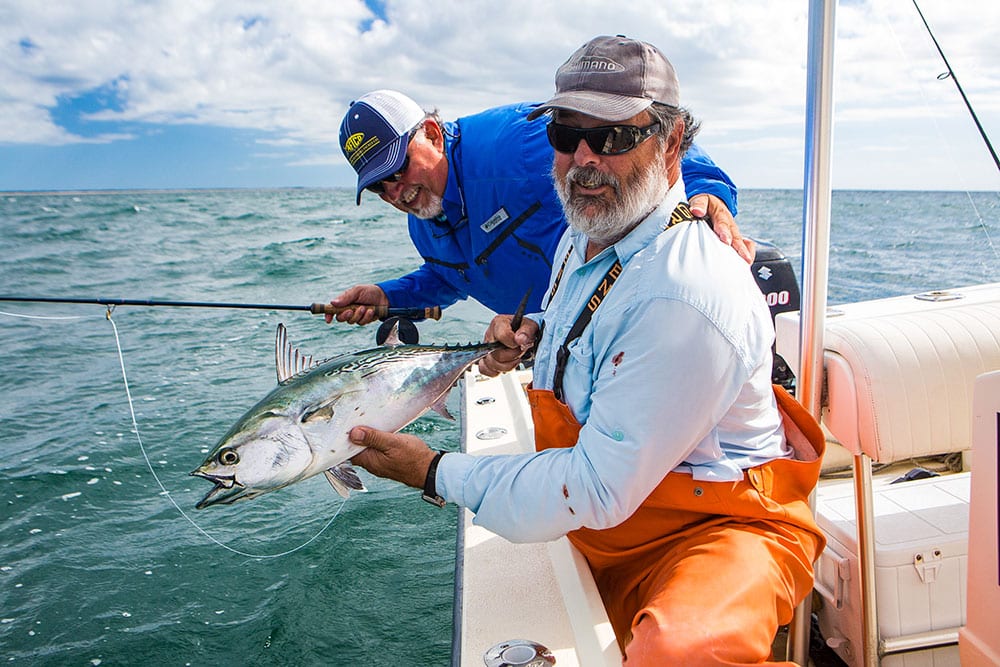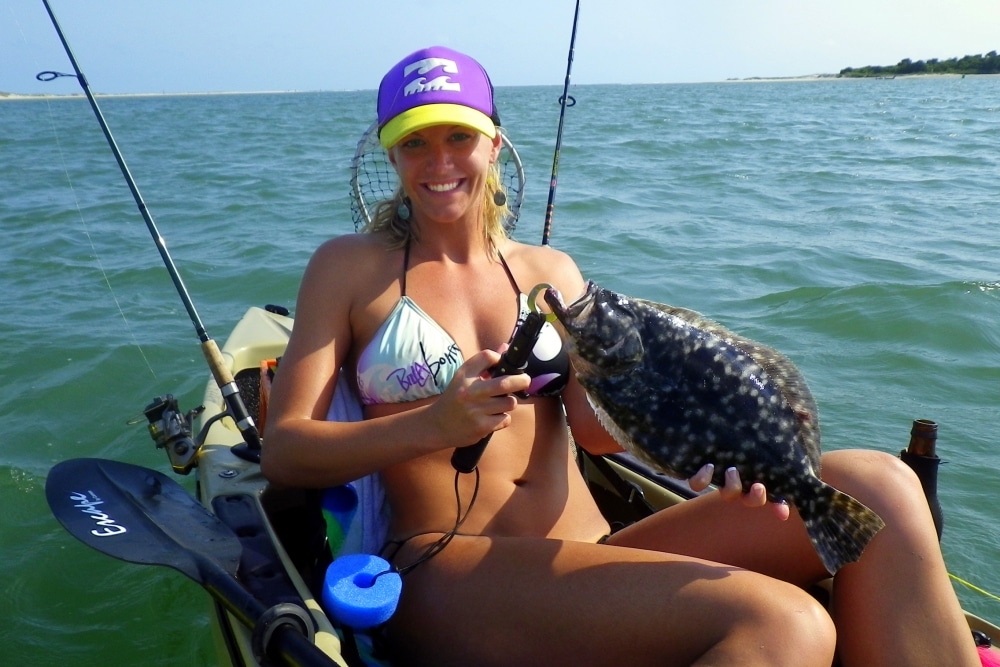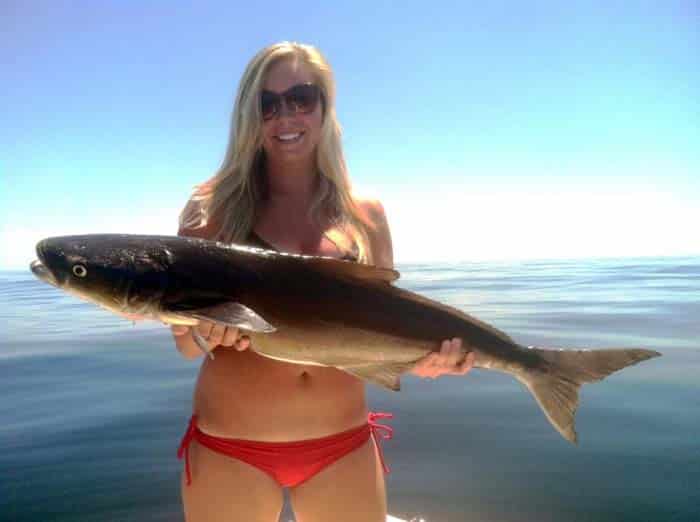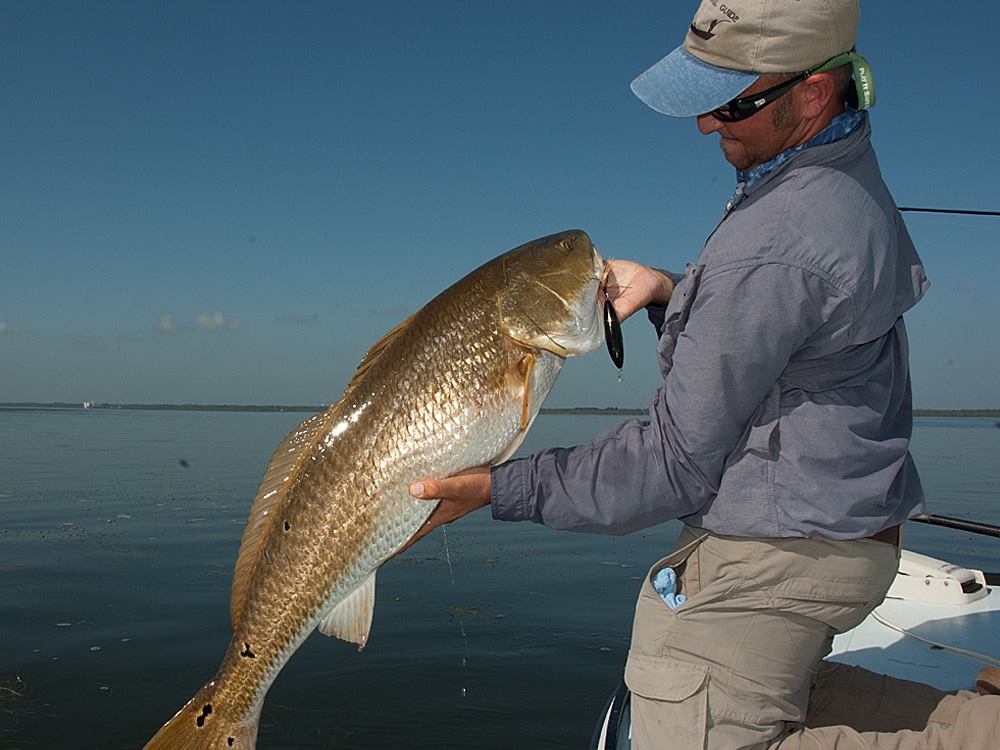
North Carolina’s offshore fishing has been making headlines since the first 1,000-plus-pound Atlantic blue marlin ever caught on rod and reel was taken out of Oregon Inlet in 1974. Since then, plenty more granders have been weighed in, and countless fish in the 700- to 900-pound range have been released in the same waters that also offer world-class white marlin action and the Hatteras/Morehead City giant bluefin fishery. In the onslaught of publicity all this has generated in recent years, another great North Carolina fishery’s been neglected by all but locals in the know. In fact, the inshore and nearshore sport fishing in Tar Heel country rivals its prestigious offshore counterpart.
According to Nags Head Capt. Brian Horsley, the impetus for this renaissance can be traced to two events: the surge in saltwater fly fishing and an all-too-rare episode of good fisheries management. “I started fly fishing here in 1977 and was one of three guides doing it,” Horsley says. “The impact of the striped bass recovery cannot be overstated, and we’ve seen saltwater fly fishing drive the popularity of inshore fishing with conventional tackle.”
This boom has prompted local guides to expand knowledge about several regional fisheries, each worthy of a feature-length article in its own right. The following pages offer a quick “lay of the land” and the means by which interested anglers can explore each fishery in depth.
Harkers Island North Carolina Fishing For False Albacore

A fishing village east of Beaufort on the intersection of Back and Core sounds, Harkers Island has always been down-home picturesque. The area hosts a nice decoy festival in the winter and offers some pretty good summer flounder fishing. Best of all, you can visit in October and November and tear up all grades of high-tech fishing equipment on giant false albacore (little tunny).
In case you haven’t had your ear to the ground, this spot has become the hottest destination in light-tackle fishing, visited by luminaries such as Lefty Kreh and George Bush.
“Harkers is a very special place,” says Capt. Sarah Gardner of Nags Head. “It’s a phenomenal fishery and an exciting experience, with all of the good will and great anglers there. A good place for do-it-yourselfers or visiting anglers to go with a guide, it exemplifies an excellent fishery and what can happen if people work together.”
With people working together, anglers catch all of the big false albacore that they can handle. If you’re a number cruncher, try 20 or 30 fish in the 10- to 15-pound range on fly tackle. Use spinning or casting gear and the numbers go up. I first fished Harkers with Capt. Sam Sellars, now semi-famous in this area as a guide for President Bush. We caught 30 false albacore — with some fish weighing around 15 pounds — on 9-weight fly rods. Fishing one afternoon with Horsley last year, we caught around 20 fish on 10-weights, including one albie in the 20-pound class. At any given time you could see a dozen boats with anglers hooked up, and we witnessed three fly rods blowing up that afternoon.
Even if you’re not a number cruncher, the fishery is appealing thanks to the chill of the Carolina coast in the fall, the wild horses of Shackleford Banks, the Cape Lookout Lighthouse and the excitement of being latched onto a mini freight train. “I love permit fishing,” Sellars says. “But I can’t think of any better place for a fly fisherman or light-tackle angler than Harkers during the fall.”
Sight fishing occurs inside Barden Inlet in the bay known as the Hook, but most year’s best action was outside the inlet, where large schools of false albacore responded to chum. Capt. George Beckwith and noted fly tier Spencer Marchant concentrated on this area to win the Hewes Light Tackle Tournament one year.
In many ways, Harkers symbolizes the rise of North Carolina’s inshore fishing. Most of the state’s best skippers work these waters in October and November, providing exposure for guides from a variety of regions. Another much desired by-product of this fishery has been an awakened interest in the need for improved fisheries management and water quality in the state. In that sense alone, the Harkers Island false albacore fishery stands out as a great success.
Fishing Nags Head and Oregon Inlet North Carolina

I confess that when I think of Bodie Island Lighthouse and Baum Bridge over Oregon Inlet, I don’t think of inshore fishing. To me, Oregon Inlet means billfish and morning rides to the Gulf Stream through a sometimes-hairy inlet. However, if you fish there in November or December with natives Horsley, Gardner or Capt. Brian DeHart, the bridge will conjure up images of big striped bass — known as rockfish from Maryland to North Carolina.
The mid-Atlantic striped bass resurgence represents a well-documented success story for a recovered fishery. However, before you congratulate the powers that be, consider the fact that allowing the fishery to collapse in the first place was not so impressive. In fact, the crash of this fishery created a widespread and long-term loss in income to recreational interests. It also meant that many people of my generation never so much as saw a striped bass until a few years ago. In any case, they’re back, they’re big and they bite nearly year-round from Nags Head north to Currituck Sound.
“Really big stripers are around when there’s very little fishing pressure,” Horsley says. “It’s nice in some ways because Sarah and I can fish together, but we’d like to have clients experience these fish, too. The only joker in the deck is the weather. If we have consistently good weather, we’ll have consistent fly or spin fishing for fish in the 40-inch class.”
While monster stripers appear in early spring and late fall, school-size fish remain available pretty much year-round, although guides refrain from targeting them during hot summer months to reduce mortality in released fish. “There’s great fishing for striped bass, but the reason I moved here is the tremendous diversity in the inshore fishery,” Gardner says. “One of our favorites is summertime wreck fishing. The area has quite a few wrecks from 2 to 10 miles out, and they offer many light-tackle options.”
The wrecks play home to most of the nearshore brutes you could itch to pick a fight with: amberjack, cobia, false albacore, barracuda, king mackerel and others. While live-bait drifting near the bottom is very successful, it by no means represents the only way to get bit. Horsley and Gardner specialize in sight-casting plug, spin and fly tackle to these fish.
“Part of the attraction of our wreck fishing lies in the sight-fishing opportunities,” Horsley says. “We catch really big amberjack and cobia on both fly and artificials by teasing them to the surface with live menhaden or bluefish. Sometimes AJs throw water in the boat as they chase the baitfish.”
Speckled trout rank as another big-time fish in the Nags Head area. The summer produces large catches of nice fish, usually taken on jigs and flies. While net bans in Florida and Texas will soon allow those states to eclipse North Carolina’s speckled trout fishery, the Tar Heel State still produces consistently good catches.
Fishing for Red Drum and Tarpon on the Pamlico Sound

They’re known as redfish in Florida and spot-tailed bass in South Carolina, but here, we just call them drum. And we’ve got big ones — not just 20-pound fish, but 60- and even 80-pounders. These monsters have their run of Pamlico Sound and, while Hatteras commands a great red drum surf fishery, the light-tackle end of the game belongs almost exclusively to two skippers: George Beckwith and Norman Miller.
Inshore red drum fishing on the Eastern Pamlico begins in April as fish leave the deep-water wrecks and head toward Hatteras, Ocracoke and Drum inlets. It lasts through the spring and kicks off again in the fall, peaking in October and November. You can count on at least a few days of spectacular migrations, where the entire gap between Portsmouth Island and Ocracoke seems covered by a mysterious golden-red carpet.
These are Miller’s home waters, and he puts his anglers onto 600 to 1,000 red drum during the season. Most fish measure longer than 16 inches, and Miller catches plenty of fish in the 40-inch class.
“Whenever I catch a big drum with a tag in it, I know it’s one of Norman’s,” Beckwith says. “He gets first shot at the fish coming through Ocracoke on their way here for the summer, then he might get some of my tagged fish as they leave in the fall. I tell people I’m just looking after his fish for the summer.”
There are plenty of fish and plenty of water for both guides to look after. “Drum over 36 inches school together. If you can find that class of fish, they will all be that size,” Miller says. “I believe I still have six existing records caught from my boat. Most of my anglers just want to catch fish, but I get a few dedicated light-tackle and fly anglers. Some of my most memorable days were spent with people like Raleigh Werking and Tom Earnhardt.”
Miller cautions that conditions may not always be right, particularly for fly fishing. Light-tackle anglers who don’t mind soaking mullet or menhaden will be able to fish if the boat can sail, but those interested in jig or plug fishing also depend on the weather.
Beckwith fishes the Western Pamlico area out of Oriental, North Carolina, long famous as a sailing stopover for boats moving up and down the Intracoastal Waterway. Drum fishing here begins in earnest in mid-July, remaining extremely consistent through the end of September. A very active tarpon bite during those months provides an added bonus.
“Owen Lupton caught the first Pamlico Sound tarpon in 1977,” Beckwith says. “We’ve started catching them consistently on bait over the last few years, but we’ve really just scratched the surface of this fishery.”
From June to mid-September, tarpon anglers can expect three or four bites on a good day and at least one shot on a bad day. Be advised that this is not flats-boat-style, shallow-water sight fishing. While you often see plenty of rolling fish, anglers haven’t been able to crack the bubble on fly-rod catches or top-water artificial lures. In any case, if you’re interested in catching tarpon in the 70-pound class (with some considerably larger fish mixed in) and 25- to 30-pound red drum on natural bait, this is your gold mine.
Fishing North Carolina’s Southern Outer Banks to Cape Fear
The southern end of the Outer Banks encompasses Portsmouth Island and Cape Lookout. With the exception of the Harkers Island false albacore fishery, inshore fishing from Portsmouth south to Pothole Creek in Onslow County offers a similar menu of opportunities.
“The most important species in this area is speckled trout,” says Capt. Joe Shute, owner of the Cape Lookout Fly Shop and an area guide. “Whether using fly, spinning or ultra-light gear, fishermen can catch good numbers of fish in the 3- or 4-pound class. We also have good puppy drum fishing in the spring and fall, as well as an excellent run of cobia in May and June.”
Farther south, the Cape Fear region offers visiting anglers options to suit all tastes. Bald Head Island features the unique charm of a remote, plush destination; Wrightsville Beach has high-dollar style; and the city of Wilmington includes Los Angeles-type traffic to go along with its upwardly mobile popularity.
Unfortunately, this boom compresses considerable recreational and commercial effort into the Wrightsville Beach area, and the region’s river-mouth location suffers from agricultural and industrial waste from upstream sources entering the watershed. However, exciting fishing awaits those who know where to look.
A couple of guys who are onto it: Capt. Lee Parsons and Tyler Stone, owner of the Intracoastal Angler in Wilmington (one of the area’s top fly and light-tackle shops).
“We have a very good light-tackle/fly fishery for Atlantic bonito off Wrightsville Beach in mid-April,” Stone says. “I expect to see more and more people exploring the Cape Fear river mouth as a result of pressure around Wrightsville Beach. Speckled trout up to 6 pounds, 12-pound flounder, and huge red and black drum are taken there regularly. You can also find tarpon both on the shoals at Bald Head and inside the river mouth. That area is the undiscovered gem of the North Carolina coast.”
Parsons has spent years developing consistent year-round fisheries for his clients. “With good weather, I can put a client onto fish any given day of the year,” Parsons says. “I’ve found very exciting, consistent light-tackle fishing, from Atlantic bonito in the spring to wreck fishing in the summer. Fall offers excellent speckled trout and mackerel, and you should really consider chasing big bluefish in the winter. Light-tackle and fly fishing for big bluefish at Frying Pan Light Tower from January through March doesn’t get much publicity, but it should.”
Considering the long seasons and inshore species the state has to offer — tarpon, red drum, false albacore, striped bass, amberjack and others — North Carolina ranks as a prime destination. And I haven’t even touched on the Roanoke River’s 100-fish-per-day striper fishery or the possibility of catching red drum, speckled trout and largemouth bass on the same drift in the Chowan River. Pamlico Sound’s budding tarpon fishery and wide-open possibilities in the Cape Fear basin only add to the varied and exciting light-tackle opportunities.
Author and accomplished fly fisherman Tom Earnhardt — considered a pioneer of North Carolina’s light-tackle inshore fishing — says he’s amazed by “the number of people who used to be strictly offshore fishermen or only fished inshore with bait and heavy spinning tackle that are now using fly rods or light-tackle artificials. It’s been really exciting for me to see this change in focus.”
Speaking from experience, it’s enough to make a dedicated offshore angler consider spending more time in a small boat in shallow water.









